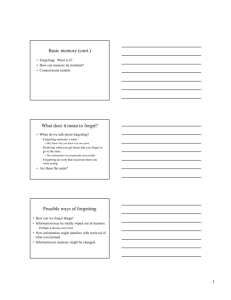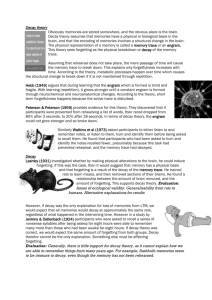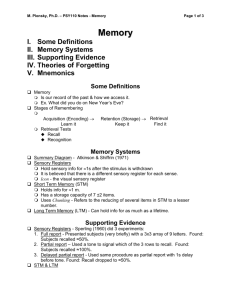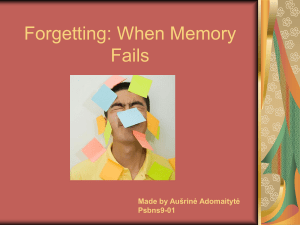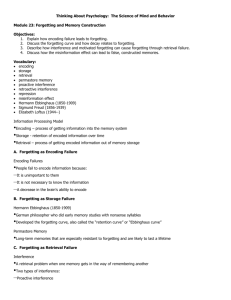Explanations of Forgetting (NM) 2011
advertisement
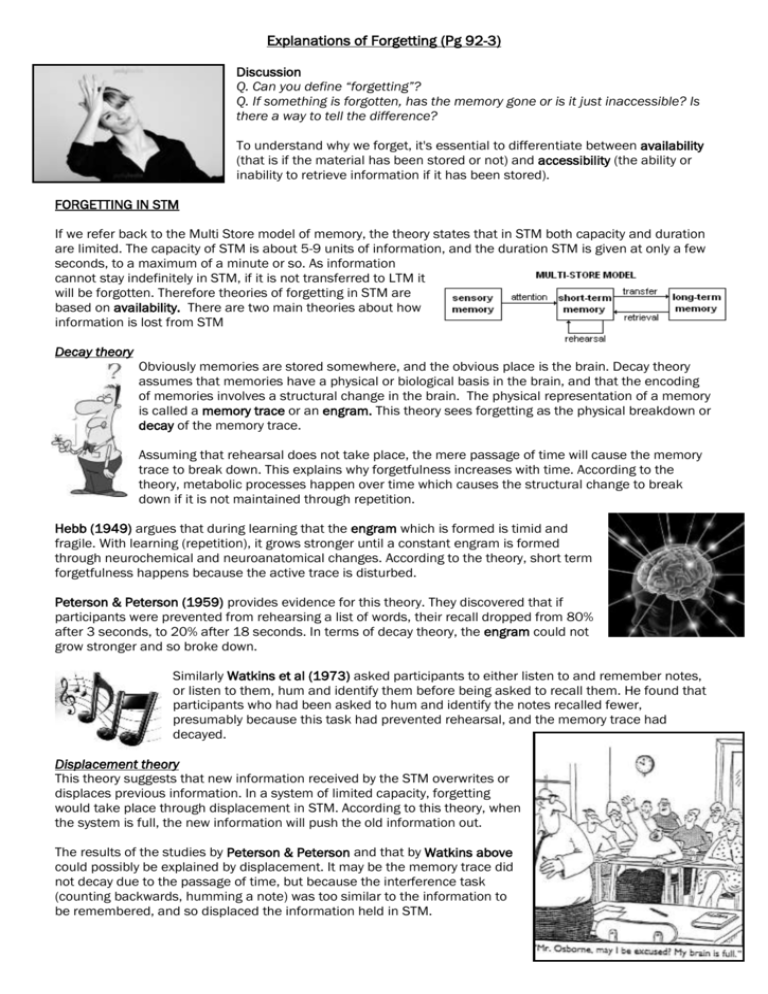
Explanations of Forgetting (Pg 92-3) Discussion Q. Can you define “forgetting”? Q. If something is forgotten, has the memory gone or is it just inaccessible? Is there a way to tell the difference? To understand why we forget, it's essential to differentiate between availability (that is if the material has been stored or not) and accessibility (the ability or inability to retrieve information if it has been stored). FORGETTING IN STM If we refer back to the Multi Store model of memory, the theory states that in STM both capacity and duration are limited. The capacity of STM is about 5-9 units of information, and the duration STM is given at only a few seconds, to a maximum of a minute or so. As information cannot stay indefinitely in STM, if it is not transferred to LTM it will be forgotten. Therefore theories of forgetting in STM are based on availability. There are two main theories about how information is lost from STM Decay theory Obviously memories are stored somewhere, and the obvious place is the brain. Decay theory assumes that memories have a physical or biological basis in the brain, and that the encoding of memories involves a structural change in the brain. The physical representation of a memory is called a memory trace or an engram. This theory sees forgetting as the physical breakdown or decay of the memory trace. Assuming that rehearsal does not take place, the mere passage of time will cause the memory trace to break down. This explains why forgetfulness increases with time. According to the theory, metabolic processes happen over time which causes the structural change to break down if it is not maintained through repetition. Hebb (1949) argues that during learning that the engram which is formed is timid and fragile. With learning (repetition), it grows stronger until a constant engram is formed through neurochemical and neuroanatomical changes. According to the theory, short term forgetfulness happens because the active trace is disturbed. Peterson & Peterson (1959) provides evidence for this theory. They discovered that if participants were prevented from rehearsing a list of words, their recall dropped from 80% after 3 seconds, to 20% after 18 seconds. In terms of decay theory, the engram could not grow stronger and so broke down. Similarly Watkins et al (1973) asked participants to either listen to and remember notes, or listen to them, hum and identify them before being asked to recall them. He found that participants who had been asked to hum and identify the notes recalled fewer, presumably because this task had prevented rehearsal, and the memory trace had decayed. Displacement theory This theory suggests that new information received by the STM overwrites or displaces previous information. In a system of limited capacity, forgetting would take place through displacement in STM. According to this theory, when the system is full, the new information will push the old information out. The results of the studies by Peterson & Peterson and that by Watkins above could possibly be explained by displacement. It may be the memory trace did not decay due to the passage of time, but because the interference task (counting backwards, humming a note) was too similar to the information to be remembered, and so displaced the information held in STM. Reitman (1974) tried to clarify the issue by giving participants word to remember, and then an interference task which would not interfere with the information to be remembered (listening for a tone). After 15 seconds, recall had dropped by 24%, which would suggest that decay rather than displacement was responsible. The serial probe technique has been used by Waugh & Norman (1965) and Shalice (1967) to investigate the issue of displacement and decay with no clear cut results. It would appear that both decay and displacement together explain forgetting in STM, but that displacement would have the stronger effect (for a more detailed explanation of this, read page 93) Evaluation of research Ecological validity? Alternative explanations? AO1 What does the MSM of memory say about forgetting in STM? What does Decay Theory say causes forgetting? What does displacement theory suggests causes forgetting? AO2 Evidence for decay and displacement o Peterson & Peterson (1959) o Watkins et al (1973) o Waugh & Norman (1965) o Shalice (1967) Evaluation of research FORGETTING IN LTM The Multistore model of memory states that LTM has an unlimited capacity, and memories have a duration of potentially forever. However, we know from our own lives that we do forget from LTM. But does that mean the memories are gone, or we just can’t reach them? Theories of forgetting in LTM therefore are a mixture of accessibility and availability. Similarly to theories of forgetting in STM, there are a number of explanations as to why we forget in LTM. Decay: we forget things because the physical memory trace has disappeared due to the passage of time Interference: when one set of learning interferes with another. For example, things learned in the past may interfere with things learned now (or vice versa) Cue dependent forgetting: information is not lost from LTM, but is simply inaccessible until an appropriate cue is given which triggers the memory (mood dependent memory is a type of cue dependent recall – see notes on the role of emotion) Decay Lashley (1931) investigated whether by making physical alterations to the brain, he could induce forgetting. If this was the case, then it would suggest that memory has a physical basis and that forgetting is a result of the decay of the memory trace. He trained rats to learn mazes, and then removed sections of their brains. He found a relationship between the amount of brain removed, and the amount of forgetting. This supports decay theory. Evaluation: Issues of ecological validity. Generalisability from rats to humans. Alternative explanations for results However, if decay was the only explanation for loss of memories from LTM, we would expect that all memories would decay at approximately the same rate, regardless of what happened in the intervening time. However in a study by Jenkins & Dallenbach (1924) participants who were asked to recall a series of nonsense syllables after being asleep for eight hours were able to remember many more than those who had been awake for eight hours. If decay theory was correct, we would expect the same amount of forgetting from both groups. Decay therefor cannot be the only explanation. Something else must be affecting forgetting. Evaluation: This study had issues with internal validity (research this for home learning). Evaluation: Generally, there is little support for decay theory, as it cannot explain how we are able to remember things from many years ago. For example, flashbulb memories seem to be immune to decay, even though the memory has not been rehearsed. Interference According to this theory there are two types of interference. Proactive interference is when previous learning interferes with later learning. Retroactive interference is when later learning disrupts earlier learning. For example, if you learned a set of facts about India, and I then asked you to learn a set of facts about China, you could experience interference in one of two ways. The facts about India could disrupt your learning of China (proactive interference) or the new facts about China could alter what you know about India (retroactive interference). A common everyday example of proactive interference is when you rearrange the location of items in a room. You may keep going back to the place where items used to be instead of where they are now! Underwood &Postman (1960) used a paired associate learning task to test the effect of interference. Participants are asked to learn a series of word pairs, so that they can be presented with the first word (the stimulus word), and recall its paired word (response word). They are then given another list of word pairs to learn which have the same stimulus word, but a different response word. Participants have their recall tested on either the first or second list of words. As expected, recall of the response words is poorer, and affected by both previous learning (proactive) and later learning (retroactive). However, this effect is only present when the same stimulus words are used in both lists. Evaluation: Ecological validity? Evaluation: Like decay theory, interference theory is a very limited explanation of forgetting. Research suggests that interference only plays a part when the two stimuli are very similar. How often would this apply to real life? A study by Tulving & Psotka (1971) initially seemed to provide evidence for interference. Participants were asked to learn a list of words which were in categories (such as, animals, furniture etc). When asked to free recall the words, as those who had only learned a few categories were able to recall a higher percentage than those who had many. This suggests that retroactive interference of the later words was causing the unlearning of the early words. However, when the participants were given the category names, recall for all participants increased, regardless of how many categories they has to learn (see textbook pg 93 for a more detailed description of this study). This cannot be explained by interference alone. Another explanation is needed. Evaluation: Ecological validity? Alternative explanation for results? Cue dependent forgetting This theory states that forgetting is not due to the loss of a memory, but rather is due to the inability to access that memory. This is known as retrieval failure. The memory is still there, but it is inaccessible. The reason that it is unavailable is because you do not have the right cue. For example, if I asked you what Freud’s first name was, you might not be able to access that piece of information. However, if I said it began with “S”, that may be enough of a cue for you to access the name “Sigmund”. Cues can either be external (something about the environment or context) or internal (something about your own state or mood). Context dependent learning (external) was demonstrated by Abernethy (1940) who found that students who sat a test in the same room, by the same instructor as in their normal lessons got higher marks. Presumably, the environment acted as a cue to memory. It’s not just the environment that can act as a cue to learning. As we looked at in the role of emotion, our internal mental or emotional state can act as a cue. This is state dependent learning. Goodwin et al (1969) found that people who had forgetting things when drunk, could recall those things when drunk again. Miles & Hardman (1998) similarly found that things learned when exercising were better remembered when exercising that when at rest. Cue dependent learning can better explain the results of Tulving & Psotka (above) than interference. Some psychologists believe that all forgetting is cue dependent. It is very difficult to test this hypothesis however, as (similarly to repression) we cannot tell if a memory is simply inaccessible, or is not there. The probability is that a lot of forgetting can be attributed to cue dependent learning, but not all. Evaluation: Ecological validity? Alternative explanation for results? Emotional explanations of forgetting We looked at some explanations of forgetting when we examined the role of emotion in memory. These are recapped below: Mood-dependent memory is a type of state dependent learning. For example, depressed people will be better able to remember memories encoded when in a depressed state previously. Repression is an explanation of forgetting which states that traumatic memories are repressed into the unconscious. Depression can cause forgetting, due to either the shrinking of the hippocampus due to a rise in cortisol of depressed people, or possible due to low motivation and inattention. AO1 What does the MSM of memory say about forgetting in LTM? What does decay Theory say causes forgetting? What does interference theory suggests causes forgetting? What does cue dependent learning suggests causes forgetting? What role does emotion play in forgetting? AO2 Evidence for decay o Lashley (1931) Evidence against decay o Jenkins & Dallenbach (1924) Evidence for interference o Underwood &Postman (1960) Evidence against interference o Tulving & Psotka (1971) Evidence for cue dependent memory o Abernethy (1940) o . Goodwin et al (1969) o Miles & Hardman (1998) Evaluation of research Discuss explanations of forgetting (25) You should have 300 words of description (AO1) i.e. describing what the various explanations of forgetting are. You should have 500 words of evaluation (AO2). i.e. o What is the evidence for and against the explanation? o Are there issues with the methodologies used? Plan your answer carefully. We have covered a lot of explanations, so it is up to you what you decide to put in your answer. You need depth and range. You could either detail a few explanations in a lot of detail, or you could detail many explanations in less detail.


